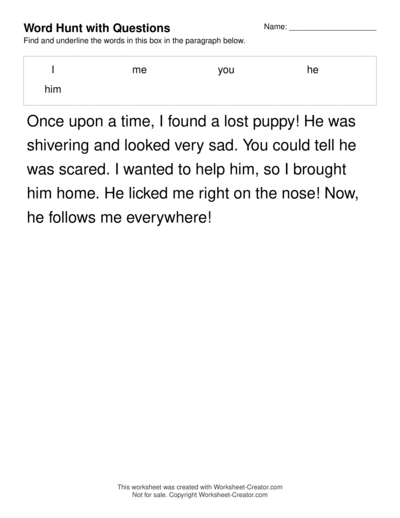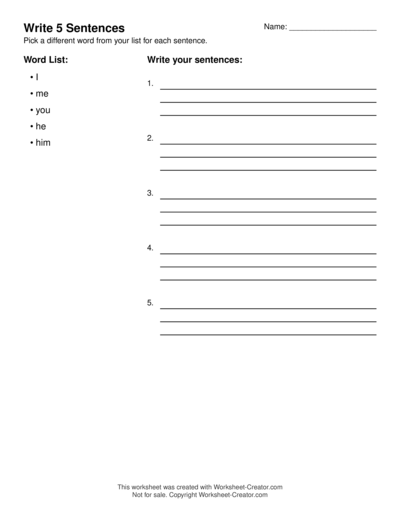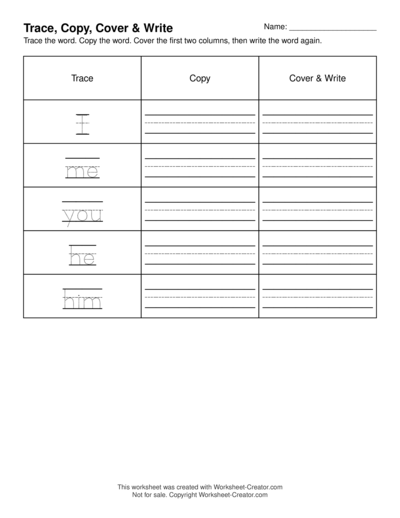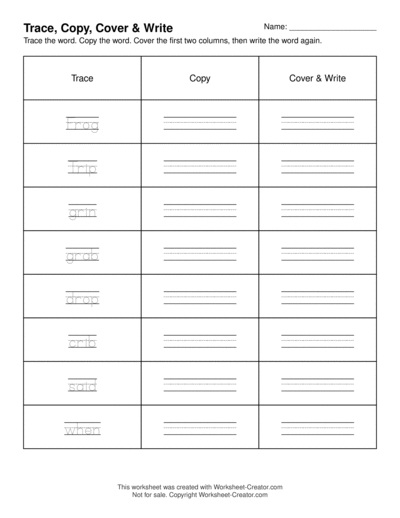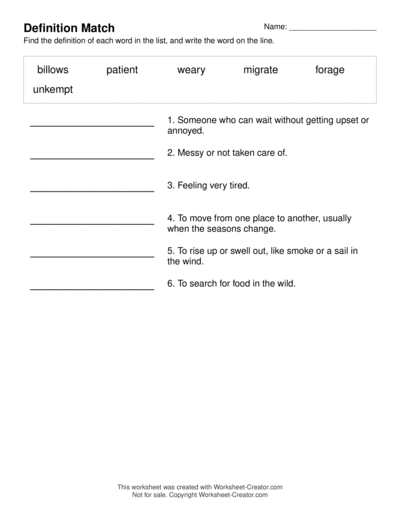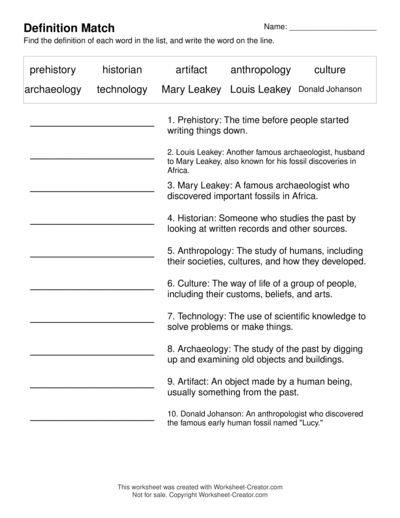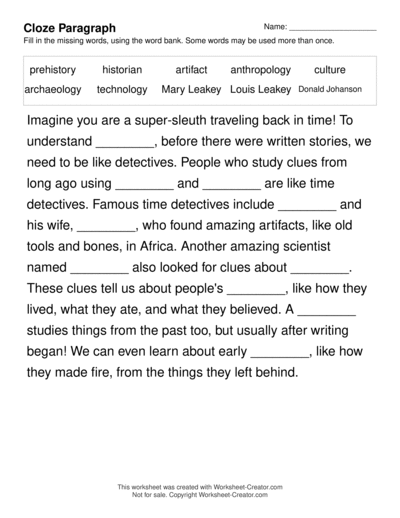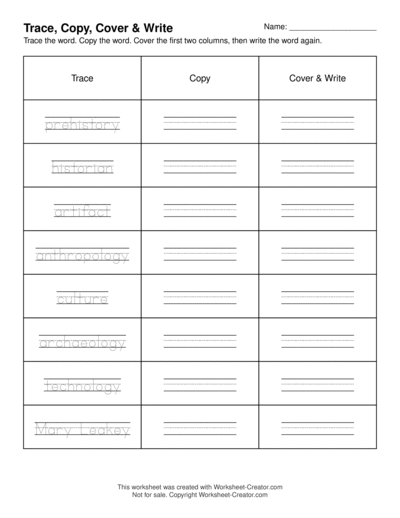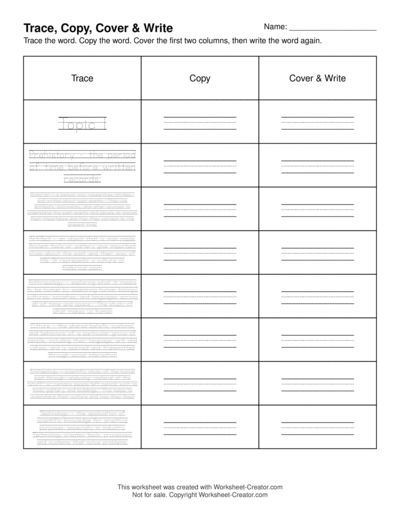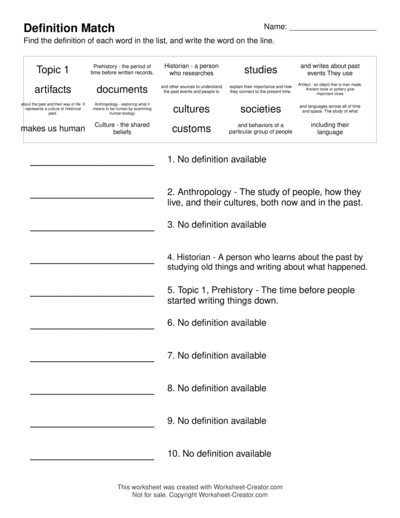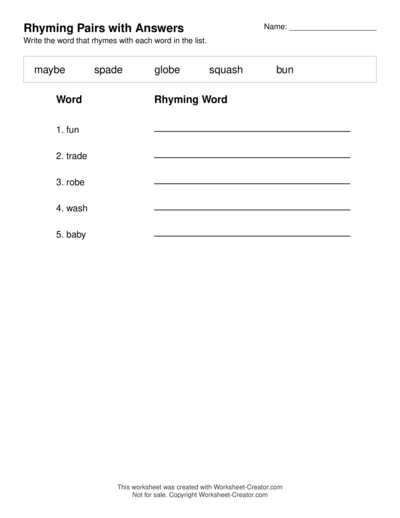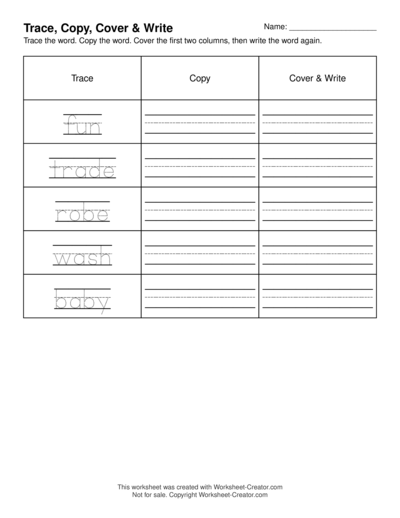1st Grade Worksheets
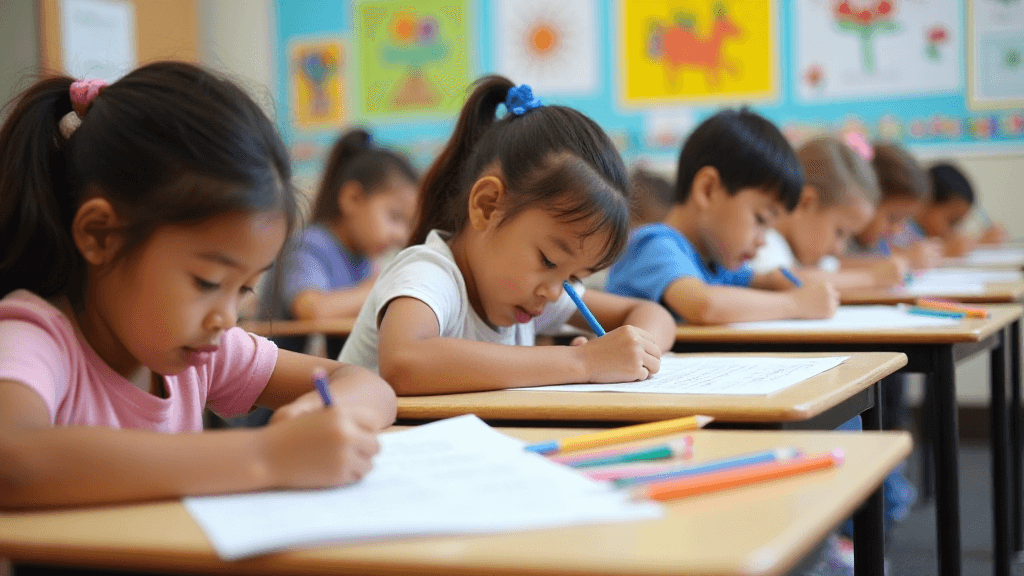
1st Grade Worksheets Store
Here are ELA, Spelling, Phonics, and Vocabulary resources for 1st grade. These are designed by teachers, and used in the classroom, today. You can add any of them to your account and customize them for free.
To download a single worksheet, you can purchase it for $2.99. Or, purchase a full year of worksheet downloads for $29.99.
Word Hunt with Questions
Words used: I, me, you, he, him
For grade level: 1st Grade
Write 5 Sentences
Words used: I, me, you, he, him
For grade level: 1st Grade
Trace, Copy, Cover & Write
Words used: I, me, you, he, him
For grade level: 1st Grade
Trace, Copy, Cover & Write
Words used: Frog, Trip, grin, grab, drop, crib, said, when, there, where, trick, dress, brushing, printing, track, pressed
For grade level: 1st Grade
Definition Match
Words used: billows, patient, weary, migrate, forage, unkempt
For grade level: 1st Grade
Created by: C. Dubuque
Definition Match
Words used: prehistory, historian, artifact, anthropology, culture, archaeology, technology, Mary Leakey, Louis Leakey, Donald Johanson
For grade level: 1st Grade
Created by: C. Dubuque
Cloze Paragraph
Words used: prehistory, historian, artifact, anthropology, culture, archaeology, technology, Mary Leakey, Louis Leakey, Donald Johanson
For grade level: 1st Grade
Created by: C. Dubuque
Trace, Copy, Cover & Write
Words used: prehistory, historian, artifact, anthropology, culture, archaeology, technology, Mary Leakey, Louis Leakey, Donald Johanson
For grade level: 1st Grade
Created by: C. Dubuque
Trace, Copy, Cover & Write
Words used: Topic 1, Prehistory - the period of time before written records., Historian - a person who researches, studies , and writes about past events They use artifacts, documents, and other sources to understand the past events and people to explain their importance and how they connect to the present time., Artifact - an object that is man made. Ancient tools or pottery give important clues about the past and their way of life. It represents a culture or historical past., Anthropology - exploring what it means to be human by examining human biology, cultures, societies, and languages across all of time and space. The study of what makes us human, Culture - the shared beliefs, customs, and behaviors of a particular group of people, including their language, art, and values, and is learned and transmitted through social interaction, Archaeology - scientific study of the human past through analyzing material of the “stuff” or remains people left behind, such as tools, pottery, and buildings. This helps to understand their culture and how they lived., Technology - the application of scientific knowledge for practical purposes, especially in industry. Technology creates tools, processes, and systems that solve problems., Mary Leakey - a British paleoanthropologist (studies human evolution by examining fossil remains) who discovered the first fossilised Proconsul skull, an extinct ape which is now believed to be ancestral to humans., Louis Leakey -Louis Leakey was a paleoanthropologist famous for finding early human fossils in Africa, which proved humans evolved there, not Asia. Working with his wife, Mary, Donald Johanson - paleoanthropologist who discovered the famous "Lucy" fossil in Ethiopia in 1974, which helped scientists understand early human ancestors and how humans evolved to walk upright.
For grade level: 1st Grade
Created by: C. Dubuque
Definition Match
Words used: Topic 1, Prehistory - the period of time before written records., Historian - a person who researches, studies, and writes about past events They use, artifacts, documents, and other sources to understand the past events and people to, explain their importance and how they connect to the present time., Artifact - an object that is man made. Ancient tools or pottery give important clues, about the past and their way of life. It represents a culture or historical past., Anthropology - exploring what it means to be human by examining human biology, cultures, societies, and languages across all of time and space. The study of what, makes us human, Culture - the shared beliefs, customs, and behaviors of a particular group of people, including their language, art, and values, and is learned and transmitted through social, interaction, Archaeology - scientific study of the human past through analyzing material of the, "stuff" or remains people left behind, such as tools, pottery, and buildings. This helps to, understand their culture and how they lived., Technology - the application of scientific knowledge for practical purposes, especially in, industry. Technology creates tools, processes, and systems that solve problems., Mary Leakey - a British paleoanthropologist (studies human evolution by examining, fossil remains) who discovered the first fossilised Proconsul skull, an extinct ape which, is now believed to be ancestral to humans., Louis Leakey -Louis Leakey was a paleoanthropologist famous for finding early human, fossils in Africa, which proved humans evolved there, not Asia. Working with his wife, Mary, Donald Johanson - paleoanthropologist who discovered the famous "Lucy" fossil in, Ethiopia in 1974, which helped scientists understand early human ancestors and how, humans evolved to walk upright.
For grade level: 1st Grade
Created by: C. Dubuque
Rhyming Pairs with Answers
Words used: fun, trade, robe, wash, baby
For grade level: 1st Grade
Trace, Copy, Cover & Write
Words used: fun, trade, robe, wash, baby
For grade level: 1st Grade
1st Grade Worksheet Generators
Do you prefer to start by generating a worksheet from one of our templates by scratch? Here are our most popular options:
Letter & Sound Practice
- Trace, Copy, Cover & Write - Perfect for practicing letter formation and sight words
- Draw and Label - Early vocabulary and picture-word association
- Rainbow Words - Fun way to practice letter recognition and formation
- Missing Letters - Reinforce the relationship of letters in words
Word Lists & Games
- 8 Words List - Perfect for creating spelling word lists and sorts
- 10 Words List - More words in the list
Why Worksheets Matter in First Grade
First grade is a crucial year in a child's reading journey. It's when students build upon their kindergarten foundations and develop essential literacy skills. The Science of Reading (SoR) research shows that systematic, explicit instruction in foundational skills like phonological awareness and phonics is vital during this stage.
Worksheets, when designed thoughtfully, can be powerful tools in your 1st grade classroom.
In a first grade classroom, well-designed worksheets serve several important purposes:
- Skill Reinforcement: They provide focused practice for newly learned phonics patterns and sight words.
- Independent Practice: They give students opportunities to apply skills they've learned in teacher-led instruction.
- Progress Monitoring: They help teachers quickly identify which students need additional support.
- Fine Motor Development: They support handwriting and letter formation practice.
- Confidence Building: They provide achievable, independent tasks that help build reading confidence.
What Makes a Good 1st Grade Worksheet?
Effective 1st grade worksheets should have these characteristics:
- Clear, Simple Instructions: Use minimal text and include visual examples when possible.
- Appropriate Font Size: Large, clear print that's easy for young readers to decode.
- Plenty of White Space: Avoid cluttered layouts that can overwhelm young learners.
- Decodable Content: Words should follow phonics patterns students have learned.
- Visual Support: Include pictures or icons to support understanding.
- Handwriting Support: Provide lined spaces for proper letter formation.
Tips for Using Worksheets Effectively in 1st Grade
- Start with Teacher Modeling: Always demonstrate the worksheet activity before students begin.
- Use as Practice, Not Instruction: Worksheets should reinforce skills that have been explicitly taught.
- Differentiate When Needed: Modify worksheets for students who need more support or challenge.
- Keep Sessions Short: 10-15 minutes of worksheet practice is usually sufficient for 1st graders.
- Make it Fun: Use worksheets as part of a game or activity to maintain engagement.
Conclusion
When used thoughtfully, worksheets can be valuable tools in your 1st grade classroom. They provide essential practice opportunities, help build confidence, and support the development of crucial reading and writing skills. Remember to choose worksheets that align with your curriculum's scope and sequence, and always use them as part of a balanced literacy program that includes plenty of teacher-led instruction and authentic reading experiences.
